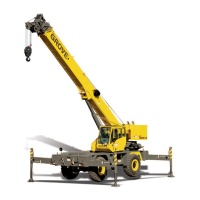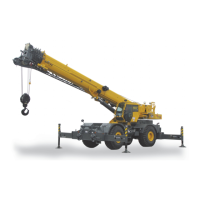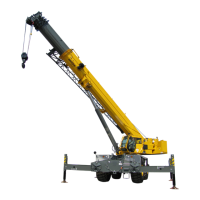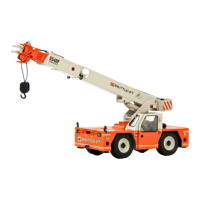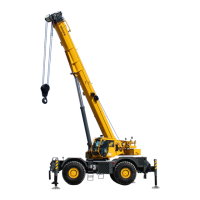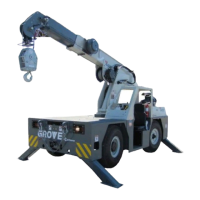Published 01-15-2016, Control # 526-01 2-5
RT540E OPERATOR MANUAL SAFETY INFORMATION
reeving, and other components to become highly stressed
and overloaded in which case the hoist rope may fail
allowing the load, block, etc. to free fall.
Two-blocking is more likely to occur when both the main and
auxiliary hoist lines are reeved over the main boom nose and
jib nose respectively. An operator, concentrating on the
specific line being used, may telescope or lower the boom
allowing the other hoist line attachment to contact the boom
or jib nose, thus causing damage to the sheaves, or causing
the hoist rope to fail, dropping the lifting device to the ground
and possibly injuring personnel working below.
Caution must be used when lowering the boom, extending
the boom or hoisting up. Let out load line(s) simultaneously
to prevent two-blocking the boom tip(s) and the hook block,
etc. The closer the load is carried to the boom nose the more
important it becomes to simultaneously let out hoist rope as
the boom is lowered. Keep load handling devices a minimum
of 107 cm (42 in) below the boom nose at all times.
Two-blocking can be prevented. Operator awareness of the
hazards of two-blocking is the most important factor in
preventing this condition. An Anti-Two-Block System is
intended to assist the operator in preventing dangerous two-
block conditions. It is not a replacement for operator
awareness and competence.
Never interfere with the proper functioning of operational
aids or warning devices.
Working Area Limiter (If Equipped)
This crane may be equipped with a working area limiter as
part of the RCL system, designated as either Work Area
Definition System (WADS) or Working Range Limiter (WRL).
You must read and understand the operator manual before
operating the working area limiter system. Become familiar
with all proper operating procedures and with the
identification of symbol usage.
The working area limiter is intended to be used as an aid to
the operator. It is not a substitute for safe crane operating
practices, experience and good operator judgements.
CRANE STABILITY/STRUCTURAL
STRENGTH
To avoid death or serious injury, ensure that the crane is on a
firm surface with load and crane’s configuration within
capacity as shown on the crane’s Load Chart and notes.
Reference Only

